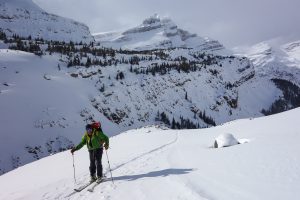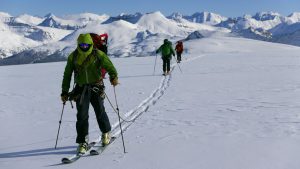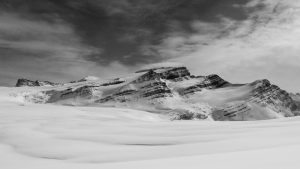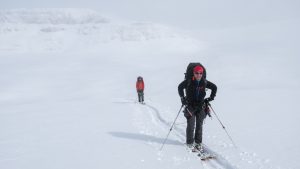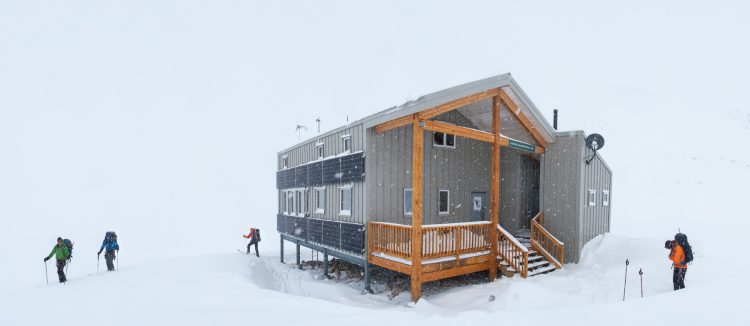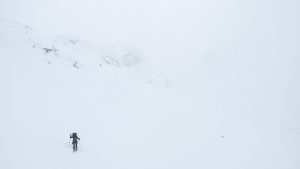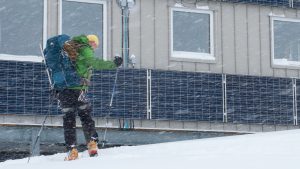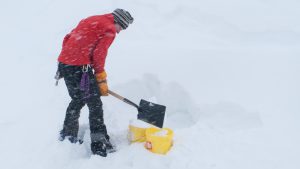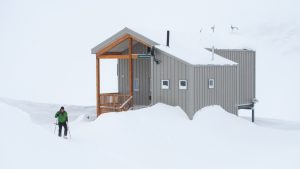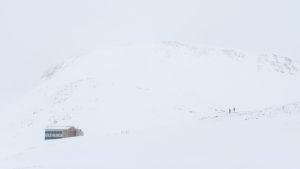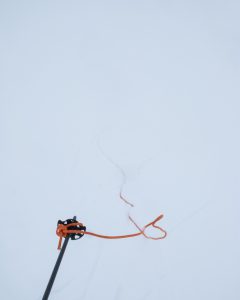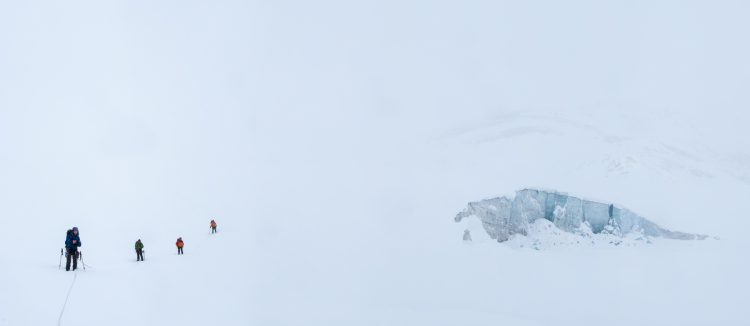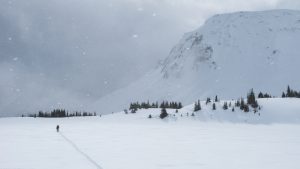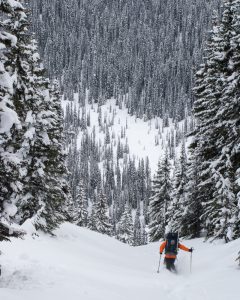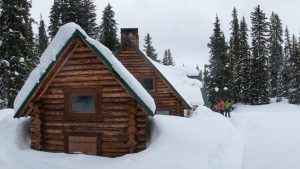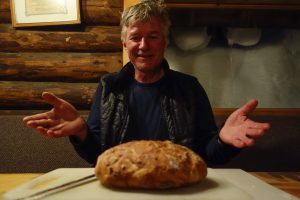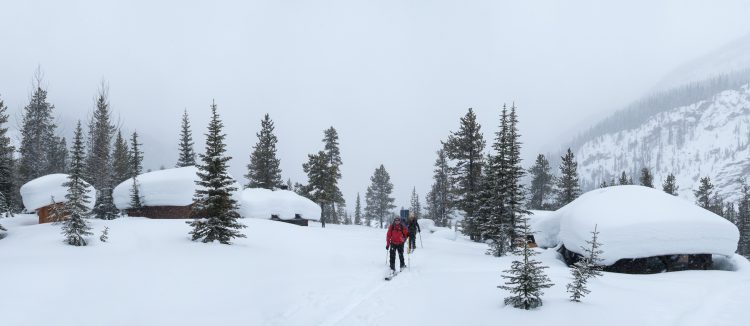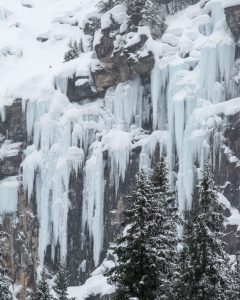The Louise and Richard Guy Hut
The Alpine Club of Canada recently raised over half a million dollars to fund the construction of a state-of-the art hut in Yoho National Park. In the summer of 2015, construction started and by December 2015 the new Louise and Richard Guy hut was completed and ready for visitors.
The ACC website has an excellent series of blog entries on the design and construction process, starting with breaking ground in late July, laying the foundation is early August, getting the SIP panels in and building the walls, and finally working through two weeks of storms in late August / early September to get the roof on.
The hut was designed to have a minimal environmental footprint, and extremely well-insulated, has 12 solar panels on south wall and two wind turbines on the roof which charge battery banks and provide power for LED lighting, exhaust fans in the kitchen and drying room, and control room and remote building monitoring.
Before the hut could be built, there were several decades of planning and meetings with Parks Canada. One of the compromises that was reached was that this hut is winter only, due to sensitive grizzly bear habitat south of the hut.
The location of this hut, just north-west of Yoho Peak, enables a safer “east-west” ski traverse of the Wapta Icefields, breaking apart the 20km day from Bow to Stanley Mitchell hut and avoiding the need to descent the steep and avalanche-prone upper slopes of the Des Poilus glacier.
Mar 8, Wednesday: In to Bow Hut
Josef, Andre, Phil, Marc and I leave Calgary just before 8 and meet in Lake Louise at around 10. Once in Lake Louise, we do the necessary car-shuttle, with Josef driving Andre, Marc and Phil up to Bow Lake, where they start skiing in, meanwhile while I wait in Louise for 1.5 hours, then Josef and I drive to the Takakkaw Falls parking lot and leave his car there, then drive my car to Bow lake. Josef and I are skiing by 2:00 under mixed cloud but cold wind in the Bow lake parking lot. I’ve really tried to minimize the gear and food on this trip, but my pack still feels heavy at about 19kg.
We stop in the sun for tea and a snack, and strip down to just shirts, basking in the heat. As we head up the canyon the wind picks up, of course, and immediately we need to put the shell jackets back on.
We’ve both been in to Bow Hut many times, and with the late start after the drive and car shuttle, we don’t waste any time and pretty much just put our heads down and go. We get to the hut in 3 hours, by 5:00.
We’ve been planning this trip for several months, and the last week or so was spent carefully weighing out portion sizes for our group meals. We are five guys, and the trip is six days and five nights, so each of us brings one group dinner. Tonight’s dinner is supplied by Marc, who brings 120g of pasta with a rich tomato sauce (800g). We set GPS way-points for tomorrow’s route to Guy hut, preparing for a whiteout, and are in bed by 9.
Thursday: Bow hut to Guy hut
We leave the hut at 8:45 after a long and solid nights sleep. The sky is clear and blue and glorious and the air temperature around -20C. We split into rope teams of 2 and 3 and ski up the glacier, heading towards St Nicolas. We are lucky that there is almost no wind, and the sun keeps the temperature comfortable despite the cold.
As we contour around Mt. Gordon and past Mt. Rhonda the views of the north side of Collie and the crevasse field below are stunning. The route from Bow to Guy hut goes up through the crevasse field and past Collie, and as we cruise down the gently sloping icefield, we have plenty of time to identify a few routes up through the crevasses. Cruising slowly downhill, with the stunning view in front and the hot sun above, we all bask in the realization that this is one of the magical moments that make all the preparations and inevitable suffering of mountaineering worthwhile.
At the bottom of the long downhill roll of the icefield we stop for lunch before climbing up through the crevasse fields to the south of Mt. Collie. The air temperature feels -5 and the sun is baking hot, a very comfortable break. I start breaking trail up the slope towards the crevasse field, one slow step at a time in the heat. Working through the heavy snow, I am taking two breaths for every step. Half way up, Josef takes over trail breaking, and we avoid a steep slope at the top by moving closer to the big crevasse that spans the glacier.
Cresting the slope the wind picks up and it gets cold immediately, and as soon as the slope flattens out we stop to put on wind-proof jackets. The day has been alternating between hot sun, and cold air, with any wind seeming to drop the temperature by 20 degrees. A beautiful day but challenging managing the temperature changes. Clouds are moving in from the west, and it looks like the glorious window of blue skies is closing.
Phil now leads us up and around a corner of the ridge coming off of Collie, just to get the view, and then we swing around 90 degrees to the east to get to the ridge leading down to the Guy hut, located at the col below Yoho peak. Getting on to this ridge is important, as it’s the safest way to access the hut, and we aim for a notch that will let us gain the final length of ridge.
Skiing across the top of the ridge on wind-blasted snow is straight forward, and then we drop down a low-angle wind-scoured slope littered with rocks to arrive at the brand-new Louise and Richard Guy Hut after six hours. The hut is set in a spectacular location at a col immediately NE of Yoho Peak at 2585m elevation.
The forecast storm has definitely arrived, with clouds coming in from the west and now light snow is falling as we take off the packs and shovel out the snowdrift blocking the front door. Feels great to get here!
Friday: Guy hut, part 1
Up at 7 after going to bed at 9 last night. The weather outside is white, snowing lightly, cloudy and foggy. Phil surprises me with a pancake breakfast this morning for my birthday. We have plans to stay two nights here if the weather is good, but it’s clearly not, so we slowly pack up for the trip to Stanley Mitchell hut and are ready to ski by 9:15. There is quite a bit of fresh snow, hard to tell how much as the hut is at a windy pass, but we ski down to the west thru maybe 15cm of powder overlying rocks and hard wind-scoured snow.
The storm and zero visibility make for tricky and completely blind skiing down the slopes below the hut, and difficult navigating between rock bands down into unknown terrain. Phil goes down a gully first, and we all stand guard at the top, watching him as he carefully works his way down, skiing first and then sidestepping through rocks. He triggers a small avalanche and guides us around to the next gully left. Marc goes first down, traversing around a rock band, out into the gully and then back below the bottom of the rocks. We are watching him from above as he works past the rocks, when he yells “I heard a whumph”. A few meters later Marc yells “slide” and is carried about 10m down the slope in a small avalanche of the new snow which had slid on the firm wind slab. Marc soon re-appears, covered in snow, and we are very relieved to see that he’s OK.
One at a time, we follow Marc’s track down and around the rock band. The avalanche crown is about 10m wide, and has run about 50m downhill. We all ski past it, one at a time, and meet Phil at a safe point. I take the lead for the next stage downhill, tying a 5m prussic rope to my ski pole and whipping it downhill so that I can see the lay of the ground for the next few meters. Without this, skiing down into the storm is completely blind. After another 200m we stop again and have a discussion whether or not we should even continue. Navigation is extremely difficult in this storm and the risk of an avalanche on the steep slope up to Isolated col is high.
We decide to turn back, without argument from anybody, at about 11:30. It’s taken us two hours to descend this slope, 200m down from the hut at 2580m just above the Glacier Des Poilus. We put on skins and work back up the slope, climbing one at a time through the steep section around the rock band and get back to the safety of the hut.
After unpacking and moving back in, we relax, talk about the morning, eat lunch and snacks, and drink tea. Josef brings cheese: Grana from Italy, strong and dry. For my birthday Andre gives me a biscotti and Josef brings out a square of Nanaimo bars with candles, followed by drinking and laughter and celebration. We especially celebrate the fact that nobody died or got hurt on my birthday, because that would have really ruined this day!
We also discuss options for tomorrow. Avalanche conditions are bad and Isolated col is likely still out, so we map out waypoints for the route around the Whaleback, a longer but safer route to Stanley Mitchell hut. If the storm is still on tomorrow, we could hang out another day and build an igloo out of all the hard snow.
In the sleeping bag around 10:00, and the wind has been blowing all evening, and doesn’t let up. The hut is powered by 12 250W solar panels and two wind turbines, and the turbines are humming with the wind. Occasionally the wind stops and the turbine hums down, only to start up again a minute later. And the wind howls and the building shakes and bangs in the storm again. It’s not looking good for tomorrow.
Saturday: Guy hut, part II
Up at 7, and it’s calm outside and snowing lightly. Clouds fill the valley and the visibility is still very bad and we slowly make breakfast and talk about options for the day.
After breakfast, nobody makes any moves to pack up on this complete white-out day. The sun is blindingly bright when it occasionally pokes out of the cloud, otherwise it’s merely very bright but still pure white.
We read and relax and drink tea, stretch and do some yoga, read some more and drink more tea. In the afternoon Marc and I go for a walk up the rocks towards the Yoho peak ridge. We don’t go very far but it feels good to get out of the hut and look around.
The clouds are filling the valley, moving in from the west and occasionally they clear, revealing views back towards the hut, the ridge behind, and hints of the ridge coming off Arete Peak to the west.
The hut is lightly stocked with reading material, a few magazines and a couple books, including the excellent The Wayfinders, by Wade Davis. We have lots of time for reading…
It snows again in the evening but the winds are calm. Folks are nervous about the descent tomorrow down to the glacier. We have have a few more days food, but are running short on whiskey and reading material! If going forward with the traverse is not possible to do safely, we can always go back to Bow hut and out to the road in one day. We’ll make a decision in the morning.
Sunday: Guy hut to Stanley Mitchell
The wind blows all night. I wake up at 5 to go to the outhouse, which in this new hut is attached to the main building but still requires a few steps outside. Opening the front door I am greeted by a blast of wind-driven snow that is swirling around and has built a new snowdrift on the patio, replacing the old snowdrift that I shoveled out yesterday. It’s not looking good for today’s trip down the nasty slope, across the glacier, through the moraine and over the end of Whaleback to get to Stanley Mitchell hut. Yesterday was a complete white-out, with thick clouds filling the valley and limiting visibility to a few hundred meters. Today we have the white out plus strong winds and more snow. Go back to bed and try to sleep for another hour before the alarms go off at 6.
It’s a quiet morning as we all eat breakfast and pack up our gear. The wind is still blowing hard, and we are all nervous about the descent down the rocky slope after our avalanche two days ago. All this snow and wind will only have made conditions more difficult and dangerous. We receive a bit of good news as the rising sun brightens the clouds and reveals that the sky has lifted compared to yesterday and visibility has improved to perhaps a kilometer. Some optimism returns to the breakfast table. If we can’t get out to Stanley Mitchell today then we will be forced to retreat back to Bow hut, a shorter trip but still a non-trivial journey across the icefield in bad weather and high avalanche risk.
By 7:30 we are out the door and starting the descent south from the Guy hut and down to the glacier. We take a line that descends farther to the south than two days ago, to avoid going around and under the rock band that Marc had his avalanche on. The snow on this side of the pass is extremely inconsistent because of the wind, and varies from bare rocks to hard wind slab to deep, soft pockets. We perform several quick stability tests and are not impressed by the results. I ski from safe point to safe point, minimizing the exposure to the unstable snowpack and aiming for a bench about 20m below. Visibility is OK, and we can see the snow surface well enough to ski and pick a decent route down the nasty slope. The bench descends gently north towards the glacier and we get down there without any issue, then put on the ropes and head up onto the glacier.
From the bottom of the nasty slope we just came down, in the once-again blowing snow and marginal visibility, the glacier appears to be a large white wall that could be difficult to get on top of. Appearances are deceiving, especially in flat light, and once we start skiing up towards it, the “white wall” morphs into a very gently rounded edge of a glacier.
Once on the glacier the visibility disappears and the world is once again pure white, and it’s impossible to tell where the white ground ends and the white sky begins. I’m at the front of the rope, being guided from behind by Phil and Marc, who are navigating by GPS waypoints that we set up yesterday. The visibility is so bad that I can’t even tell which way the glacier is sloping, so I’ve tied a 5m piece of rope to the end of my ski pole and whip it out in front of me, “feeling” the snow ahead by observing which way the rope falls on the surface. It’s also the only way that I’ll avoid falling over a snow-lip or into a crevasse.
The major obstacle on this glacier is a large ice-cliff at the toe that drops into a lake. This cliff is relatively new, formed in the last few years as the glacier retreats rapidly up valley, and is not marked on maps. We have set up the GPS waypoints to guide us around it, but as we approach the toe of the glacier I see a white edge appearing out of the mist and am extra vigilant about making sure we keep well away. As we navigate and feel our way slowly off the glacier on the western edge, around a few big holes that appear out of the mist, the ice cliff suddenly appears on our left, a crescent shaped blue wall probably 30m high.
We are all relieved that two of the three major obstacles are behind us now, and we continue breaking trail across the rolling terrain towards the junction of the Twin Falls and Whaleback trails. As we ski down the valley bottom we get a good look at Isolated Col and are unanimously happy to not be heading up there in the current avalanche conditions.
There are numerous point-release avalanches that have come off the steep rocky eastern end of the Whaleback, some of which ran to valley bottom, and we give the run-out zone wide clearance. On the way up the Whaleback trail we put an up track through an absolutely beautiful treed slope, but nobody can be convinced to ski a run. Sigh.
The third potential problem area of the day is the descent down the south side of the Whaleback trail. The summer trail switchbacks steeply down a south-facing gully, and all this fresh snow could be an issue in warm weather. When we get there we dig a pit at the top of the steep treed slope leading into the gully, and the test results are solid, so down we go. The powder is somewhat heavy and at least boot deep, and we all enjoy the first really good turns of this ski trip.
To celebrate arriving at the cozy and historic Stanley Mitchell hut, Josef bakes bread to have with dinner. It turns out very well, crusty and chewy and warm, and it’s fantastic to have fresh bread in the back-country. It also gives a sense of history, since in the old days, when this hut was built, people would bake bread here all the time, since it’s actually very space-and-weight efficient to bring flour on trips like this.
We left the Guy hut at 7:30 and arrive at Stanley Mitchell at 2:30, seven hours, taking only short breaks. I joke with Phil that arriving at Stanley Mitchell hut, surrounded by green trees, warm sun and a friendly wood stove, how it feels good to be back in civilization.
Andre jokes that the main reason he came on this traverse was to ski at Stanley Mitchell, but didn’t want to ski the 9 hours up the road. So basically we took a five day trip to save a nine hour slog.
Monday: Takakkaw Falls exit
At 11pm last night I was awoken by clomping of ski boots, banging pot lids, thumping packs on the floor, the rustle of nylon clothing and the whispers of people trying to be quiet. I roll over and try to go back to sleep, wondering who it was that showed up so late and what their story is…
In the morning we meet our four new hut-mates, and hear their story. Yesterday they had left the Mitchell hut to ski up and over Isolated Col (the high route that we did not take because of bad avalanche conditions), heading north to get to Guy hut. They encountered bad avalanche conditions on the south side of Isolated Col, but were able to get up there safely, and after digging two pits on the north side of the col, surprisingly found very good stability and had an excellent ski down to the valley. After crossing the Des Poilus glacier, they headed up the nasty slope towards the col of Yoho Peak to get to the Guy hut. Visibility was poor, and they could not see well enough to find a good route through this complex and tricky terrain. Part way up, they remote-triggered a slab avalanche that buried one of their group chest-deep, fortunately without injuries! Then, being only 15 minutes from the Guy hut, but unable to proceed safely, they made the difficult decision to turn around and ski all the way back to Stanley Mitchell hut. They did most of that in the dark, and were very happy to have our tracks to follow up and over the Whaleback.
It’s 24km from Stanley Mitchell hut to the highway, roughly half of that along a mostly-flat road. We get up early in the morning, anticipating at least five hours to get down the road, depending on snow and trail conditions. The skiing down the Little Yoho valley east of the hut is downhill through gently rolling terrain along the summer hiking trail. The big factor in how efficiently we can move is how well we can make the heavy backcountry skis kick-and-glide like a cross-country ski, which is all about wax.
And while we do have general-purpose “ultra-blue” kick wax, nobody has the correct wax for these warm conditions.
There is some nice tree-skiing on the way down to Laughing Falls, as we exit the Little Yoho Valley to join the main Yoho Valley trail, but the snow is heavy and crunchy with debris from mushrooms that have fallen off of the trees.
It’s snowing and the clouds sit low and heavy. The day is really just “put your head down and go” and we only take minimal food and water breaks. The snow is heavy, wet, warm powder, and people’s skis are either too slippery, not able to get any grip, or too sticky, causing the snow to collect on the bottom of the ski and preventing any gliding. Frustration levels are rising and there’s not much talking.
Just get it done.
The switchbacks, where the road drops into a spectacular canyon, are a major milestone, and after that it’s another 5km along the road, following the Yoho river to where it joins the Kicking Horse river and then finally the parking lot by the highway.
We all celebrate arriving at the car, after five hours. Josef, Andre and I drop the other guys off at Lake Louise and head up the Jasper highway to fetch my car from Bow Lake.
Thanks for a great trip in challenging conditions!
– Darren Foltinek, March 2017



